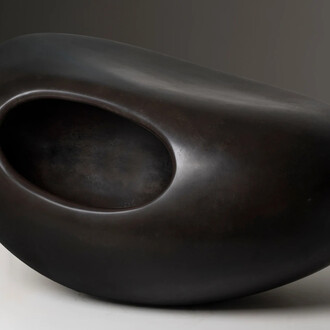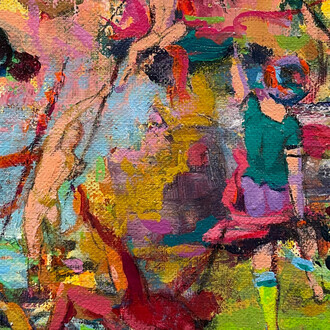Space 776 presents Fragile states at Volta Art Fair New York 2024, featuring the evocative works of Katherine Jackson, Frank Olt, and Dasha Bazanova. This curated exhibit explores the relationship between environmental change and the impact of war, offering a profound exploration through diverse mediums and themes. Katherine Jackson's delicate glass sculptures and Frank Olt's abstract landscapes invite viewers to reflect on the fragility and resilience of nature and the human spirit amid conflict. Dasha Bazanova's Social club tub sculptures use ironic humor and satire to critique societal excess and its consequences. Together, these works challenge attendees to consider the fragile state of our world and the profound impact of human actions on society and the environment.
Katherine Jackson's work compellingly explores themes of conflict and environmental impact through innovative glass sculptures. In Partial eclipse (2017), bulletproof glass shattered by gunfire transforms violent bullet holes into patterns resembling flowers. This poetic transformation critiques the paradox of using force for safety while reflecting on the broader effects of warfare on society and nature.
In Little oils, Katherine Jackson presents glass figurines shaped like oil cans, each distinct in size, style, and color. Displayed on illuminated light boxes, these pieces connect natural resources to the machinery of war. Some are modeled after a soldier's uniform, highlighting the personal toll of conflict. Together, they offer a subtle critique on the disposability of resources and lives in wartime, reflecting on the intersection of human conflict and environmental exploitation.
Dasha Bazanova's Social club tub sculptures intricately weave together themes of war, environmental degradation, and the societal impact of overconsumption. Made from ceramic with recycled melted glass and gold luster, these pieces humorously depict characters in scenes that highlight the absurdity and despair of excessive lifestyles. These figures, often shown in states of disillusionment, symbolize the broader human struggle against socio-political and economic pressures intensified by global conflicts. Each tub is paired with an animation, displayed on a monitor, that brings the static sculptures to life and deepens viewer engagement with the narrative.
Bazanova’s work powerfully connects to the art fair's themes by reflecting on how warfare accelerates environmental destruction and societal collapse, compelling viewers to consider the cyclical relationship between conflict and consumption. By employing recycled materials, Bazanova not only underscores the necessity of sustainability but also provokes a critical reevaluation of our environmental impact amid global conflicts. Her sculptures serve as a poignant commentary on the urgent need to alter our consumption patterns, which are intertwined with both the degradation of our planet and the perpetuation of conflict.
Frank Olt’s artistry bridges the historical and contemporary, merging abstract ceramic and painting techniques reminiscent of the New York school with poignant themes that resonate with the flower power movement of the 1960s and 70s—his works, such as See grass trees, 2024 and Sunflowers, 2024. The second one draws directly on the sunflower—a national symbol of Ukraine—depicting the landscape both in peace and during wartime. This duality reflects not only the resilience and beauty of nature but also its vulnerability in the face of conflict, echoing the transformation of violence into patterns of flowers in Katherine Jackson’s Bullet Glass series.
Olt's Field of eight further extends this dialogue, portraying the desolation post-conflict through vivid, haunting use of red, evoking the stark emptiness after destruction and loss. His pieces engage in a visual conversation with Lorraine Schneider’s iconic 1968 anti-war poster, "War is not healthy for children and other living things," which utilized the flower as a symbol of life and resistance against violence. By integrating elements that suggest both the mechanized aspects of war and the organic forms of landscapes and horizons, Olt's work compels viewers to reflect on the cyclical nature of destruction and regeneration, urging a reconsideration of the impacts of war on both human and environmental health.
Katherine Jackson is a Brooklyn-based artist who works with drawing, glass, and light. Her work has been exhibited extensively in museums, galleries, colleges & universities, and public spaces in New York City, elsewhere in the US, Rome, Berlin, and Venice. Two of her large/scale long-term public exhibitions celebrated the centennials of two iconic New York structures, the New York Public Library and the Manhattan Bridge. She was awarded a grant to place a 6-month exhibition addressing immigration in NY's Tenement Museum. A recent installation was included in both the Venice Architectural Biennale 2021 and the Venice Art Biennale 2022.
Dasha Bazanova was born and raised in Russia. She holds master's degrees in marketing from Moscow State Institute of International Relations (2011), and Fine Arts (MFA) at Long Island University (CW Post) (2014). She lives and works in New York. Her work was exhibited in US galleries, museums, and art fairs. She recently had solo exhibitions at the Spring Break Art Show / NYC 2022, and 2023. As Well as Space 776 Gallery, NYC in March 2024. Beth Rubin Dewoody and Stephanie Ingrassia collect Bazanova’s artwork.
Frank Olt is an artist whose studio practice focuses on ceramics and painting. He is a former artist-in-residence at MoMA P.S.1. He studied with Bauhaus artist Rose Krebs. Olt exhibited and has collectors nationally and internationally. His commissions include all ceramic art at the 23rd & Ely subway station through the NYC Arts for Transit program and Bellevue Hospital. His work was exhibited recently in a one-person show in the Contemporary Gallery at Nassau County Museum of Art.
















